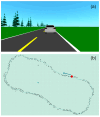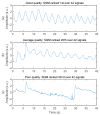Respiratory Monitoring with Textile Inductive Electrodes in Driving Applications: Effect of Electrode's Positioning and Form Factor on Signal Quality
- PMID: 40218548
- PMCID: PMC11991506
- DOI: 10.3390/s25072035
Respiratory Monitoring with Textile Inductive Electrodes in Driving Applications: Effect of Electrode's Positioning and Form Factor on Signal Quality
Abstract
This paper provides insights into where and how to integrate textile inductive electrodes into a car to record optimal-quality respiratory signals. Electrodes of various shapes and sizes were integrated into the seat belt and the seat back of a driving simulator car seat. The electrodes covered various parts of the body: upper back, middle back, lower back, chest, and waist. Three subjects completed driving circuits with their breathing signals being recorded. In general, signal quality while driving versus sitting still was similar, compared to a previous study of ours with no body movements. In terms of positioning, electrodes on seat belt provided better signal quality compared to seat back. Signal quality was directly proportional to electrode's height on the back, with upper back outperforming both middle and lower back. Electrodes on the waist provided either similar or superior signal quality compared to electrodes on the chest. In terms of form factor, rectangular shape outperformed circular shape on seat back. Signal quality is proportional to the size of circular electrodes on seat back, and inversely proportional to size of rectangular electrode on seat belt.
Keywords: automobile; automotive application; breathing sensor; driver health status; driving application; inductive sensing; respiratory monitoring; respiratory signal; signal quality index; textile inductive electrode.
Conflict of interest statement
The authors declare no conflict of interest. The funders had no role in the design of the study; in the collection, analyses, or interpretation of data; in the writing of the manuscript; or in the decision to publish the results.
Figures











Similar articles
-
A Quantitative Method to Guide the Integration of Textile Inductive Electrodes in Automotive Applications for Respiratory Monitoring.Sensors (Basel). 2024 Nov 23;24(23):7483. doi: 10.3390/s24237483. Sensors (Basel). 2024. PMID: 39686021 Free PMC article.
-
On-Road Evaluation of Unobtrusive In-Car Respiration Monitoring.Sensors (Basel). 2024 Jul 11;24(14):4500. doi: 10.3390/s24144500. Sensors (Basel). 2024. PMID: 39065897 Free PMC article.
-
Vital Sign Monitoring Through the Back Using an UWB Impulse Radar With Body Coupled Antennas.IEEE Trans Biomed Circuits Syst. 2018 Apr;12(2):292-302. doi: 10.1109/TBCAS.2018.2799322. IEEE Trans Biomed Circuits Syst. 2018. PMID: 29570057
-
Sitting biomechanics, part II: optimal car driver's seat and optimal driver's spinal model.J Manipulative Physiol Ther. 2000 Jan;23(1):37-47. J Manipulative Physiol Ther. 2000. PMID: 10658875 Review.
-
Recent Advances and Challenges in Textile Electrodes for Wearable Biopotential Signal Monitoring: A Comprehensive Review.Biosensors (Basel). 2023 Jun 26;13(7):679. doi: 10.3390/bios13070679. Biosensors (Basel). 2023. PMID: 37504078 Free PMC article. Review.
References
-
- Khan M.A., Sayed H.E., Malik S., Zia T., Khan J., Alkaabi N., Ignatious H. Level-5 autonomous driving—Are we there yet? a review of research literature. ACM Comput. Surv. (CSUR) 2022;55:1–38. doi: 10.1145/3485767. - DOI
-
- Zhao J., Zhao W., Deng B., Wang Z., Zhang F., Zheng W., Cao W., Nan J., Lian Y., Burke A.F. Autonomous driving system: A comprehensive survey. Expert Syst. Appl. 2023;242:122836.
-
- Rhiu I., Kwon S., Bahn S., Yun M.H., Yu W. Research Issues in Smart Vehicles and Elderly Drivers: A Literature Review. Int. J. Hum.—Comput. Interact. 2015;31:635–666. doi: 10.1080/10447318.2015.1070540. - DOI
MeSH terms
Grants and funding
LinkOut - more resources
Full Text Sources

